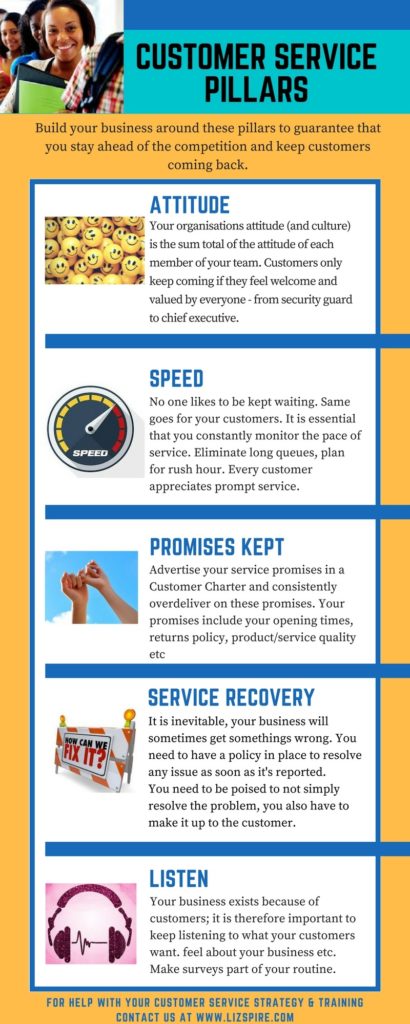
In Part 1 of this series we said great companies stay in business when customers keep coming back. We also said that we could keep customers coming back by maintaining an excellent attitude towards them and by offering services with alacrity (speed). This week we will conclude by showing how we can keep customers coming back by keeping our promises, service recovery and by listening to customers.
You can go back to the home page to read the first part of this series.
You can download our infographic here.
Promises Kept: When was the last time a company failed in keeping their promise to you?
You visited your bank to complain about something. The customer service officer promised to investigate and call you within the hour with feedback. You wait till the end of the day and realize that that promise was just to get you out of the bank.
You also realize something more serious: this company does not respect its customers. This company does not keep its promises. You begin to wonder about the company’s commitment to keeping other promises it’s made to you.
 Back to the bank example: the bank has promised to keep your money safe; will they? The bank has promised to provide emergency working capital overdraft when your business needs it; will they? The bank has promised that you will have access to your money anywhere in the world through your debit card; will you?
Back to the bank example: the bank has promised to keep your money safe; will they? The bank has promised to provide emergency working capital overdraft when your business needs it; will they? The bank has promised that you will have access to your money anywhere in the world through your debit card; will you?
Now with this doubt comes the biggest question. Should you continue with this banking relationship when the bank can’t keep even the simplest of promises to call back with information?
How does a company get its employees to keep their promises to customers? It starts by creating the culture of keeping its promises. First keep promises to employees. Do not shift goal posts; if you make a policy stick to it irrespective of whose ox is gored. Let your people see you keeping promises.
Like kids clue into what’s important to mom/dad and avoid stepping out of line, your team will know what’s important and do what it takes to maintain this culture.
A company that keeps its promises keeps its customers for life.
Related reading: The Power of Keeping Promises
Service Recovery: It’s inevitable; every business will once in a while make a mistake. Fail in keeping a promise to a customer, meeting a deadline, providing a service, expressing a positive attitude etc. What happens when things go wrong?
It’s tempting when things go wrong to choose to say nothing, do nothing and hope that time will heal every slight. This is the worst thing to do. In service, customers are like elephants, they have very long memories. Saying and doing nothing is lighting the way so your customers waltz into the arms of your competition.
Four months ago I had a horrid experience at my hairdressers. The stylist made a tangled mess of my natural afro hair and the only solution was to cut my hair. The stylist insisted that he had done nothing wrong, and the issue was that my hair was ‘difficult’. I was vocally upset about the entire situation. The manager did nothing to find out what caused the ruckus and insisted I pay full price for the service.
I ended up leaving their establishment to another hairdresser who fortunately did not have to cut my hair (although it took two long hours to comb out the bird nest on my head).
Last week I met another stylist from my previous hairdresser (yes, I left them for good); and she said her manager was waiting for me to come back so she would resolve the issue. When I asked why the problem wasn’t addressed at the time the incident happened, she said the manager wanted to give me time to ‘calm down’. It’s been four months.
No matter the industry, customers get rubbed off the wrong way; every company must have some semblance of a policy that allows staff resolve the issue as swiftly as possible to salvage the customer relationship.
Service Recovery refers to those actions you take to appease and compensate the customer for the poor service received. Service Recovery strategies are just that, strategies. They are not off the cuff plans to bribe the clients.
Going back to my hairdresser experience, what could the salon owner have done to appease and compensate me for the poor service received? I would recommend any or all:
- The manager should personally apologize for the incident
- Have some other hairdresser on staff fix my hair
- A discount on the bill would definitely have doused any remaining anger.
- A call from the owner acknowledging the incident and apologizing
- Offering a coupon for future treatments at the hairdressers
These would have worked for me; that does not necessarily mean it will work for everyone. If you were in my shoes, what would work for you?
My mentor John Tschohl wrote about this extensively in a previous blog post. You can read more about service recovery here.
Listen: Without customers your business will cease to exist. To remain viable you need to keep giving customers what they want; but how will you know what your customers want if you do not continuously listen to what they are saying to you?
Like this ride, you need to always keep a line of connection between you and your customers firm and open.
There is so much value in listening to customers; listening to customers can revolutionize your business. Listening feeds your business creativity; it lets you know what customers really think about your brand and products.
But is it possible to listen to all your customers? What if you have thousands or millions? Have you thought of surveys, customer visits, campaigns, focus groups etc? There are so many ways, and with advancements in technology it no longer has to be a time consuming or costly exercise.
Related Reading: 8 Ways to Listen to Your Customers
As I wrote the post, I thought about my own business. I had to ask myself tough questions about my attitude, speed of service, promises to customers etc. Do I even do enough to listen to my customers? It was quite an eye opener.
The point is no matter how good you think you are, there is always room for improvement. Your business will thank you for it. As will your customers.
I’d like to know your thoughts about this post. Let’s get the conversation going.




